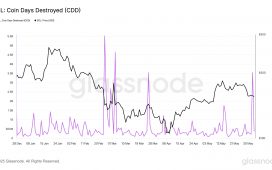
A sudden burst of energy that surges through our brains as we die could be evidence of the ‘soul leaving the body’, a professor has claimed.
Researchers have long documented patients experiencing lucid, lifelike hallucinations after clinical death, when the heart stops pumping but the brain flickers with electrical activity.
Dr Stuart Hameroff, a professor of anesthesiology and psychology at the University of Arizona, said when the patient does die, brain activity could hint we have ‘souls’.
George Washington University researchers placed small sensors on the brains of seven clinically dead patients minutes before their life support was switched off in 2009.
‘They saw everything go away and then you got this activity when there was no blood pressure, no heart rate,’ Hameroff told Project Unity in an interview Tuesday.
Hameroff said the researchers noticed a sudden flurry of brain activity in one patient, called gamma waves, believed to be involved in sleep, perception and movement.

These waves, produced by neurons’ firing on and off at the same time, lasted up to 90 seconds and were picked up on an electroencephalogram (EEG).
But as Hameroof stressed, they were being produced even after the heart stopped beating.
‘So that could be the near-death experience, or it could be the soul leaving the body, perhaps,’ he added.
The patients in the study, who all decided to stop their end-of-life care, included two men and five women aged between 34 to 74.
The anaesthesiologist said consciousness, our inner world, is found at a ‘deeper level’ of our biological plumbing than we think.
So deep, he said, that our minds could operate on a quantum level – matter and energy at its most fundamental level.

Rather than neurons zapping one another creating consciousness, it could be microtubules, tiny cellular structures made of protein that control the shape of the cell and how it divides.
This means our consciousness is the ‘last thing to go’ when we die.
‘The point is it shows that consciousness is actually, probably, a very low energy process,’ Hameroff, who has been working on the controversial theory of quantum consciousness since 1996, said.
The researchers added: ‘As the brain reaches a critical level of hypoxia, the [action potential, an electrical signal that shoots down a neuron] is lost by large numbers of neurons, and this loss of electrical potential causes a cascade of electrical act.’
They suggested, as others have done, that this is what causes the vivid, realistic visions experienced by some human victims of cardiac arrest.
Some who survive say these sights, called deathbed visions or ‘out-of-body experiences’, can include visions of an afterlife or the supernatural.

While the range of those who experience them can vary, 88% of patients who survive a near-death experience report at least one vision
‘We offer this as a potential explanation for the clarity in which many patients have “out-of-body experiences” when successfully revived from a near-death event,’ the researchers said.
Activity associated with information processing in a dying brain can be eight times what it is during a conscious state.
Hameroff also cited a study by Dr Robin Lester Carhart-Harris that looked into how mind-altering drugs can affect mental health and behaviour.
He asked volunteers to slide into MRI machines or be monitored by an EEG while they received a drip of psilocybin, the compound in magic mushrooms.
As the machine whirred, patients closed their eyes and let whatever groovy whirl of colours and hallucinations came their way.
Yet Cahart-Harris and his team found the MRI was ‘cold and dark as if they were comatose’.
‘I think they were expecting the MRI to light up like a pinball machine when they gave them the psilocybin because all this stuff would be going on,’ Hameroff said.
‘They were at a loss to explain this.’
Get in touch with our news team by emailing us at webnews@metro.co.uk.
For more stories like this, check our news page.










